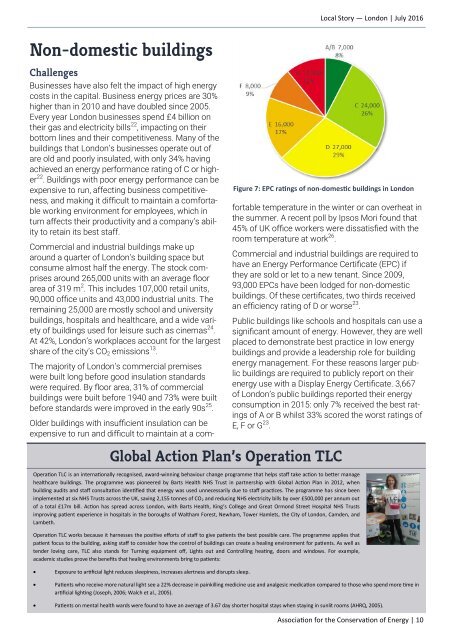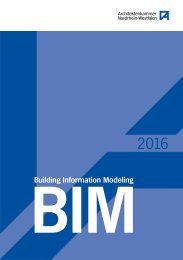Energy Efficiency in London
2bvXHkT
2bvXHkT
Create successful ePaper yourself
Turn your PDF publications into a flip-book with our unique Google optimized e-Paper software.
Local Story — <strong>London</strong> | July 2016<br />
Non-domestic build<strong>in</strong>gs<br />
Challenges<br />
Bus<strong>in</strong>esses have also felt the impact of high energy<br />
costs <strong>in</strong> the capital. Bus<strong>in</strong>ess energy prices are 30%<br />
higher than <strong>in</strong> 2010 and have doubled s<strong>in</strong>ce 2005.<br />
Every year <strong>London</strong> bus<strong>in</strong>esses spend £4 billion on<br />
their gas and electricity bills 22 , impact<strong>in</strong>g on their<br />
bottom l<strong>in</strong>es and their competitiveness. Many of the<br />
build<strong>in</strong>gs that <strong>London</strong>’s bus<strong>in</strong>esses operate out of<br />
are old and poorly <strong>in</strong>sulated, with only 34% hav<strong>in</strong>g<br />
achieved an energy performance rat<strong>in</strong>g of C or higher<br />
22 . Build<strong>in</strong>gs with poor energy performance can be<br />
expensive to run, affect<strong>in</strong>g bus<strong>in</strong>ess competitiveness,<br />
and mak<strong>in</strong>g it difficult to ma<strong>in</strong>ta<strong>in</strong> a comfortable<br />
work<strong>in</strong>g environment for employees, which <strong>in</strong><br />
turn affects their productivity and a company’s ability<br />
to reta<strong>in</strong> its best staff.<br />
Commercial and <strong>in</strong>dustrial build<strong>in</strong>gs make up<br />
around a quarter of <strong>London</strong>’s build<strong>in</strong>g space but<br />
consume almost half the energy. The stock comprises<br />
around 265,000 units with an average floor<br />
area of 319 m 2 . This <strong>in</strong>cludes 107,000 retail units,<br />
90,000 office units and 43,000 <strong>in</strong>dustrial units. The<br />
rema<strong>in</strong><strong>in</strong>g 25,000 are mostly school and university<br />
build<strong>in</strong>gs, hospitals and healthcare, and a wide variety<br />
of build<strong>in</strong>gs used for leisure such as c<strong>in</strong>emas 24 .<br />
At 42%, <strong>London</strong>’s workplaces account for the largest<br />
share of the city’s CO 2 emissions 13 .<br />
The majority of <strong>London</strong>’s commercial premises<br />
were built long before good <strong>in</strong>sulation standards<br />
were required. By floor area, 31% of commercial<br />
build<strong>in</strong>gs were built before 1940 and 73% were built<br />
before standards were improved <strong>in</strong> the early 90s 25 .<br />
Figure 7: EPC rat<strong>in</strong>gs of non-domestic build<strong>in</strong>gs <strong>in</strong> <strong>London</strong><br />
Older build<strong>in</strong>gs with <strong>in</strong>sufficient <strong>in</strong>sulation can be<br />
expensive to run and difficult to ma<strong>in</strong>ta<strong>in</strong> at a comfortable<br />
temperature <strong>in</strong> the w<strong>in</strong>ter or can overheat <strong>in</strong><br />
the summer. A recent poll by Ipsos Mori found that<br />
45% of UK office workers were dissatisfied with the<br />
room temperature at work 26 .<br />
Commercial and <strong>in</strong>dustrial build<strong>in</strong>gs are required to<br />
have an <strong>Energy</strong> Performance Certificate (EPC) if<br />
they are sold or let to a new tenant. S<strong>in</strong>ce 2009,<br />
93,000 EPCs have been lodged for non-domestic<br />
build<strong>in</strong>gs. Of these certificates, two thirds received<br />
an efficiency rat<strong>in</strong>g of D or worse 23 .<br />
Public build<strong>in</strong>gs like schools and hospitals can use a<br />
significant amount of energy. However, they are well<br />
placed to demonstrate best practice <strong>in</strong> low energy<br />
build<strong>in</strong>gs and provide a leadership role for build<strong>in</strong>g<br />
energy management. For these reasons larger public<br />
build<strong>in</strong>gs are required to publicly report on their<br />
energy use with a Display <strong>Energy</strong> Certificate. 3,667<br />
of <strong>London</strong>’s public build<strong>in</strong>gs reported their energy<br />
consumption <strong>in</strong> 2015: only 7% received the best rat<strong>in</strong>gs<br />
of A or B whilst 33% scored the worst rat<strong>in</strong>gs of<br />
E, F or G 23 .<br />
Global Action Plan’s Operation TLC<br />
Operation TLC is an <strong>in</strong>ternationally recognised, award-w<strong>in</strong>n<strong>in</strong>g behaviour change programme that helps staff take action to better manage<br />
healthcare build<strong>in</strong>gs. The programme was pioneered by Barts Health NHS Trust <strong>in</strong> partnership with Global Action Plan <strong>in</strong> 2012, when<br />
build<strong>in</strong>g audits and staff consultation identified that energy was used unnecessarily due to staff practices. The programme has s<strong>in</strong>ce been<br />
implemented at six NHS Trusts across the UK, sav<strong>in</strong>g 2,155 tonnes of CO 2 and reduc<strong>in</strong>g NHS electricity bills by over £500,000 per annum out<br />
of a total £17m bill. Action has spread across <strong>London</strong>, with Barts Health, K<strong>in</strong>g’s College and Great Ormond Street Hospital NHS Trusts<br />
improv<strong>in</strong>g patient experience <strong>in</strong> hospitals <strong>in</strong> the boroughs of Waltham Forest, Newham, Tower Hamlets, the City of <strong>London</strong>, Camden, and<br />
Lambeth.<br />
Operation TLC works because it harnesses the positive efforts of staff to give patients the best possible care. The programme applies that<br />
patient focus to the build<strong>in</strong>g, ask<strong>in</strong>g staff to consider how the control of build<strong>in</strong>gs can create a heal<strong>in</strong>g environment for patients. As well as<br />
tender lov<strong>in</strong>g care, TLC also stands for Turn<strong>in</strong>g equipment off, Lights out and Controll<strong>in</strong>g heat<strong>in</strong>g, doors and w<strong>in</strong>dows. For example,<br />
academic studies prove the benefits that heal<strong>in</strong>g environments br<strong>in</strong>g to patients:<br />
<br />
<br />
Exposure to artificial light reduces sleep<strong>in</strong>ess, <strong>in</strong>creases alertness and disrupts sleep.<br />
Patients who receive more natural light see a 22% decrease <strong>in</strong> pa<strong>in</strong>kill<strong>in</strong>g medic<strong>in</strong>e use and analgesic medication compared to those who spend more time <strong>in</strong><br />
artificial light<strong>in</strong>g (Joseph, 2006; Walch et al., 2005).<br />
Patients on mental health wards were found to have an average of 3.67 day shorter hospital stays when stay<strong>in</strong>g <strong>in</strong> sunlit rooms (AHRQ, 2005).<br />
Association for the Conservation of <strong>Energy</strong> | 10







